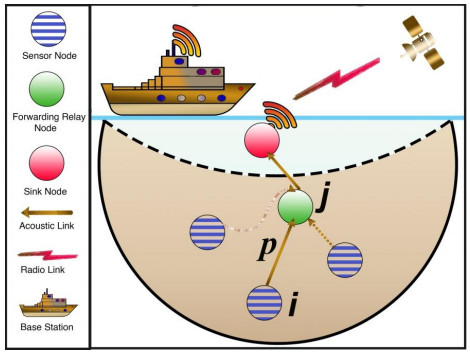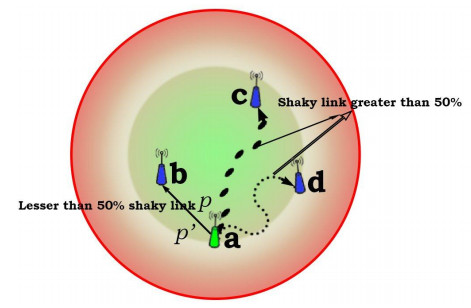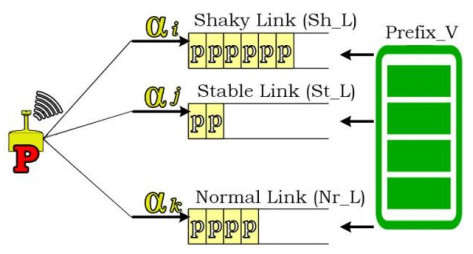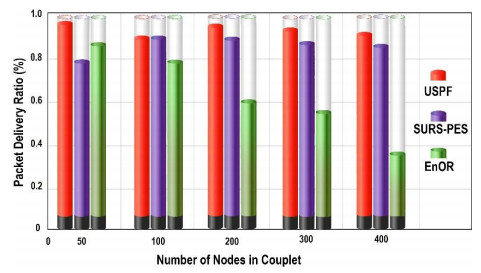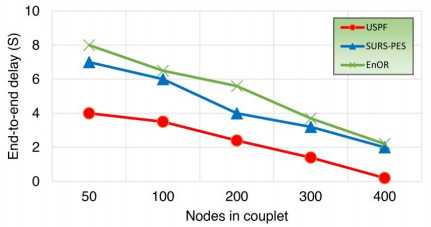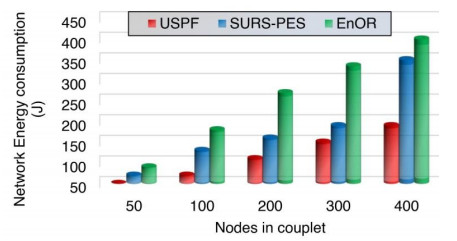The sensor nodes deployed in underwater environment has different routing mechanism in contrast to the terrestrial network. Getting underwater data on pollution detection, control of the ecosystem, marine mining, catastrophe avoidance and strategic surveillance thereby demands smooth packet transmission which can only be possible through a stable and astute communication link between sensor nodes. Therefore, selecting best link between source and destination node is a key challenge. The meticulous research has been conducted to search out the best link selection mechanism of bodacious underwater routing protocol EnOR, SURS‐PES and USPF; and recommended the protocol that offers a shrewd communication link. The performance has been evaluated through NS2 simulation for packet delivery ratio, end-to-end delay, network lifespan and network energy consumption.
1.
Introduction
Traditionally, a UWSN consists of underwater sensor nodes, which are used to sense the atmosphere and unusual activities, and shore sonobuoys (sinks), that are responsible for gathering sensed data from the nodes. Optical and radio frequency interactions in such networks are generally deemed infeasible because optical signals suffer from extreme interference, while high-energy radio signals are easily absorbed due to high attenuation [1]. The acoustic channel was therefore seen as the only feasible system for wireless contact underwater. None the less, this system brings restricted network efficiency, large and intermittent delays, transient loss of path and large noise, multi-path flickering, shadow zones and high energy cost of contact.
Acoustically, the underwater wave operates at 1500 m/s, which is less than the electromagnetic wave frequency in five order magnitudes [2]. The acoustic channel has a continuum of temporal frequency with spatial underuse. Numerous challenges are faced by UWSN’s low bandwidth with absurdly high channel error rate, transient route failure and weak channel multipaths, including nodes displacement 2-3 m/s at water current unlike the terrestrial device [3]. Even while the speed of the acoustic wave is seemingly constant underwater, but due to the unpredictable nature of submarine organisms and water current, as it hits the sea, it reflects in multipurpose directions. Therefore, variations in sound speed are achieved, but a directional transmission can decrease this likelihood.
The multi-hop routing causes packet failure with an expected delay factor contributing to poor communication, so enough re-transmissions are needed to transmit packets reliably. Under these volatile and tough environments, the localized sensor nodes are completely battery-dependent and hard to replace, though replacement will increase high bits [4]. UWSN enhances the dimensions of exploration from underwater warfare to unforeseen and uncertain circumstances, such as ocean collisions, atmosphere and seismic warnings, the quality of pollutants, situational monitoring, sampling offshore and navigation. The UWSNs have given incredible success in the petroleum and gas business. Oceanographic data, mine identifications, underwater tracking and seafood items may also be collected [5]. A submarine protocol specifies the size of a load and bit error packet. Not only does the network output degrade but also wastes resources through inadequate packet size selection. The efficiency of the underwater network depends greatly on topology architecture, which is driven by a selection process for epitome relief nodes that increases the likelihood of transmission to the destination node. Intelligent topology has a very smaller energy consumption ratio than an insecure and less efficient topology [6].
The meticulously findings have been conducted in regards to the communication link selection process thereby considered three state of the art underwater routing protocols and their link establishment process has been analyzed by focusing the methodology which each protocol has adopted and through obtained results in terms of end-to-end delay, network throughput and energy consumption. At the end we came up with best link selection result adopted by one of these protocols. We came across some challenges still faced by the underwater routing and that needs to be considered for future findings.
a. There are two types of routing topologies underwater: Motion dependent topologies, and Coverage dependent topologies. The fixed or localized nodes are followed by a motion-based routing, whereas the coverage-based routing allows UWSN two dimensional and three dimensions [7].
b. Motion based UWSN: Sensor nodes are positioned at defined positions such as, surface buoys or bottom surface to track the other underwater constituent. Such localized sensor nodes had specific fidget characteristics; dynamically and continuously shifting position floats, driven primarily by a navigation device.
c. Coverage based UWSN: It comprises primarily of two-dimensional architecture and three-dimensional architecture. The sensor nodes are anchored at the same depth for a two-dimensional topology and use the underwater bridge for contact that is responsible for capturing and transporting raw data to offshore station. The sink nods are set with a horizontal and vertical transceiver that captures sensed data from the nodes surrounding it. The sea is 10 km deep and the vertical transceiver is to be appropriately long, transmitting data to an offshore station while the horizontal transceiver performs the sensory node order for the acquisition of sensation data. The sinks are fitted with acoustic transceiver and wireless transmitter for the control of several parallel communications [8]. Underwater sensor nodes can have a direct connection via multi-hop path (relay node) to sink node or in-line link. For a sink node far from the sensor node the power needed to send the packet will decrease by a value of over two of the distance [9], the direct link is an easy communication route but not a resource-efficient solution indeed. It also entails high transmitting capacity and is likely to will the network efficiency and the effect may be significant acoustic interference [10]. A multi-shop communication strategy raises the latency factor as data is exchanged between intermediate nodes in the maze of the routing. Furthermore, in terms of contact ability, two-dimensional underwater routing faces main challenges; selection of the water surface and the size. An improved version of a 2D UWSN is a three-dimensional underwater sensor network; the sensor nodes freely float at arbitrary water level to collect sensed data. Adherence of the sensor nodes at the bottom is a more jingoistic strategy, so buoy retains the sensor nodes so draws into the surface of the water [11]. Depth of anchor nodes may be managed by changing the length of the cable. Some barriers to 3D undersea contact are obstructed, such as the sensor depth should be ingenuously modified to intelligently acquire sensed data and the network topology should be linked.
Astute contributions
It is essentially a daunting task to define the sagacious communication link between sensor nodes from source to destination. Our technique has yielded enough output in this reference. Following contributions have been made in this research work.
● We experience the identification by EnOR, SURS‐PES and USPF of the actual link selection mechanism; by description in specific figures as readers and researchers can easily understand without wasting time reading the entire paper.
● The performance of all protocol has been pragmatically observed in terms of packet delivery ratio, end-to-end delay, network lifespan and network energy consumption. We experienced amazing results i.e., all protocols have varying deficiencies but there is a protocol that was controlling the extra energy utilization, due to its bodacious link selection mechanism.
● We identified the feature that was preventing the energy utilization. In fact, it leads to three state link selection mechanism out of which, it only selects the link which has higher potential comparing with pre-assigned values through additive rise and fall method.
● This protocol came up, carrying maximum data rate from source to destination; which shows that it possessed sagacious link selection mechanism that was our prime task.
The article is structured as follows. Section 2 describes the related findings with critical attributes. Acoustic signal propagation has been covered in section 3. Section 4 addresses the link selection methodologies. Results and discussion have been placed in section 5, while some open challenges and conclusions were outlined in sections 6 and 7 respectively.
2.
Critical review
The underwater sensor network has developed sagacious advancements in connection environment, media connectivity, mapping, encoding and propagation technique. The energy use during the emergence of relay nodes is examined as an energy model in first exchange in [12], with sufficient energy route occupying exceptionally intermediate relay nodes at an optimal range, but without any implications for the forwarding structure. The author [13], suggested a vector-based forwarding mechanism (VBF), thereby a virtual pathway between source and destination node has been setup to deliver the data packets. The target node examines whether or not the packet is part of the virtual pipeline and, if so, validates factors that can be retained in time [14]. The packet is sent any time the same sender will quickly be forced to die, wasting exorbitant resources and growing the probability of packet loss. It is not possible for a fragmented network as pathways in virtual pipelines are fragile.
An energy-aware, void routing concept is blowing out by [15], (EAVARP), in which the author structures the conical shells around the sinking node and the sensor nodes inside such shells dynamically. Where data packets are inside the same shell, residual energy is transmitted that lets every empty area be circumvented if it occurs. However, the authors suggest an imaginative solution to the energy loss module, which as a result, shortens the lifetime of the network.
Huang et al [16], have designed a fuzzy-based routing approach to utilize the resource efficiently. The battery power is being utilized efficiently at a trivial level, the network overhead and packet delivery latency has been controlled. Indeed, in complex scenarios, this system increases uncertainty and offers no remedy for crash avoidance.
An esteemed QELAR method is proposed for the application of the adaptive routing protocol by Tiansi Hu et al [17]. It initiates a reward feature which uses the residual energy of sensor nodes evenly to be calculated and distributed, while nodes will remain alive throughout the application. The recompense function allocates relay nodes to the routing debut. Although the efficiency is awesome, but regular residual changes are bottlenecking in the network.
Sungryul et al [18], suggested a power transfer model making channel stability. The power effect has been evaluated by the amplitude of modifying waves, in the power transmission adjustment where the height of the wave determines the surface signal reflection and signal frequency transmitted to node. The value calculated may be used to determine the wave root mean square (RMS). Both nodes and corresponding frequencies should be equilibrated with wave height RMS, which is unable to be seen in the tests. The authors argue that the implementation of such a mechanism may lower significant energy consumption and thus reduce the transmission power of the node, but that no effective action to deal with this atrophy which can generate network congestion is addressed when the wave height is gradually reduced to empty level.
By dividing transmission to two parts, Cao J, et al [19], proposed the BTM balance transmission system, dividing the transmission into node results. Depending upon the energy level of the nearest nodes, nodes determine the single-hop or multi-hop spread of the data. The direct transference of one-hop data to the sink takes place if the voltage of the surrounding node is below the intensity level of the transmission node [20]. Data is also transmitted to the destination sink through multi-hop transfers. This network integrates energy consumption in two opposing nodes. Nevertheless, there is only 1 relay node in each network, and unrealized transmissions are sometimes made when traffic, nodes and battery transmission effects are unevenly distributed.
3.
Underwater acoustic signal propagation mechanism
A highly dynamic undersea environment and acoustic communication is often subject to variable factors which require an acoustic channel’s bandwidth to remain and to only stay on the frequency and distance of a sensor node [21]. The communicating underwater varies shallow and deep by ocean division. Slightly shallow water had high temperature, a multipath effect, a surface disturbance, and a broad pause in propagation that eventually adversely affected the output of sound signals; whereas a deep-water sea had the same history with specific measurements [22]. Several malicious dissemination components are evaluated in sequence as pragmatically.
3.1. Factors affecting underwater acoustic communication
Underwater environments are defined as major propagation factors that influence acoustic communication:
i.) Path loss: the diffusion effect indirectly raises the
underwater temperature resulting in vacillated movement between the sensor nodes and signal power. The lack of direction is further split into three parts.
a. Geometric Spanning Error: the sound wave is distant but unchanged from frequency [23], where spheric spreading losses arise in deep water, creating a cylindrical lack of stretching in low water.
b. Signal Attenuation: Attenuation is based on frequency and distance between the nodes [24]. That is since acoustic energy is transformed into another form of energy such as heat energy.
c. Dispersion: This happens by shifting angles of acoustic waves. Varying wind speeds cause surface roughness to increase the decline of the dispersion barrier, ultimately causing a delay in transmission and loss of power in subsequent communications [25].
ii.) High propagated delay: When the acoustic signal acts at 1500 m/s, the transmission has an endless delay factor of approximately 0.67 s/km, leading to a high propagated layoff.
iii.) Noise Ratio: Any inevitable signal intensity condition atrophy forces the device to incorporate a noise ratio. Ambient noise exists in the case of UWSN because of multiple unidentifiable unknown sources. There are four types of ambient noises: (i) wind noise; (ii) noise; (iii) thermal noise. A wind noise created by the varying wind speeds causing acoustic waves to break down. Owing to the acoustic wave interference that is induced by shipping voyage produces acoustic signal hurdles. Sea surge induces small vibration, which creates noise during communication. A machine also generates a suitable noise, called an anto-noise, that doesn’t mimic other sounds, it has a similar relation to thermal noise level.
iv.) Multipath Tangle: Multipath enigma: Multipaths are generated in underwater communication where sounds waves impact the water surface and the depths of the ocean, causing uncoherent acoustic communication interference, resulting in erroneous signal and a multipath effect [26]. An acoustic channel's impulse response leaves the variable propagation and power effect dissident. Due to uneven sound speed, many paths are created, and only limited reflection is taken into account and the loss of energy is taken into account.
The geographical dynamic routing can be separated in three prominent categories for UWSNs, according to the number and location of destinations, namely unicast, anycast, and geocast. A comparative analysis among these transmission routings are placed in Table 1. Generally, all underwater routing approaches have local and global considerations whereas a global approach requires a high overhead computation relative to the local one, and the source node in the network thereby preserved [27]. Moreover, picking of next forwarding node is typically accomplished by dividing the opportunistic routing into two classes: location-base and location-free routing [28]. The location dependent routing picks the forwarding node by taking in account the distance or depth metric up to the node.
4.
Link selection methodologies
Deployed sensor nodes broadcast data packets within the transmission range to neighboring nodes, creating two transmission zones. A successfully generated transmission node transfers data to the sink node and transfers it for further processing to the offshore station. There are three separate communication channels from the source to the relay node and from the relay to the sink node [29]. A most secure connection is preferred and therefore named sagacious connection, although other connections are overlooked. A thorough analysis of the connection selection process under three state-of-the-art routing protocols was studied and efficiency assessed. Via the packet delivery radio, end-to-end delay, network lifespan and network energy consumption we concluded that connection selection strategy provides optimal and shrewd output. The key results of the wise selection process for such protocols were explored one at a time.
4.1. Energy balancing routing protocol for underwater sensor networks (EnOR)
Rodolfo W, et al [30], discussed one of the immutability problems relating to the priority level of transmission of nodes, resulting in balanced power usage and extended lifespan of UWSN network. It rotates the priority level of transmission for the transmission nodes, taking into account the remaining capacity, reliability of the connection and progression of packets as illustrated in Figure 1. Node i setup communication link by broadcasting p packets to neighbouring nodes. Eventually, node j found to be a most reliable node thereby, stable link has been setup.
Link Selection methodology: When the packets like, p are periodically transmitted by each underwater sensor node. The lightning packet comprises the identity of the sender, the remaining information on its energy and its size. Algorithm 1 establishes the criteria of best link selection mechanism.
Algorithm 1 explanation
Using i as a sensor node with a data packet to be sent while maintain the neighbouring table as Ni. The node analyses its adjacent nodes to choose the most suitable nodes to be forwarded (lines 2–7). For this function, only if a neighboring node advances towards the surface sonobuoys can a candidate node be considered (Lines 3–6). A difference between the current I node sender depth and j in Pj = depth(i) - depth(j) is used to measure a packet advancement for a neighbor j. The fitness of the neighbor j is then determined (line 5). Using connection reliability, packet progress and remaining energy to assess the suitability of a nearby node. This is measured in line 5 and thus as Eq (1).
where Pj > 0 represents packet advancement of node j; p(dj, m) is an estimation of data packet of m between node i and node j; Ejrem shows remaining potency of j; and Ejinit is the initial value of potency of j. The nodes allowed the connection to be selected and sorted by fitness value (line 8). Finally, from the potential nodes the relation set is calculated. A limited link set can lead to low reliability of the link. At the other side, a wide connecting set may also damage the query, because it takes a long time. The possible node connections are applied to the whole collection until the required link reliability γ is reached.
4.2. Design of shrewd underwater routing synergy
Using Porous Energy Shells (SURS‐PES)
[31]: To transmit the data packet from source to sink-node, authors used a newly-developed link with residual energy and depth detail. In an area where energy usage has direct impact as the entire active underwater nodes rely on batteries and when cost-effective data packets are delivered, no charge or replacement steps are taken becomes a crucial factor. The authors utilized a shrewd link selection mechanism, if a link is less than or equivalent to 50% shaky, after broadcasting of a sensor node the destination node is checked, and the destination node is returned to the source node, adding some unusable porous energy shell to strengthen a link from 5% to full 90, and then transmitting it to the target.
Link Selection methodology: The link quality inspection has been taken through link reparation mechanism that is depicted in Figure 2. Sensor node, a, broadcasts the packet, p, with substantial information such as depth, ID, and residual energy towards neighboring nodes, i.e., b,
c, and d. The source node, Na is broadcasting the packet towards neighbors, upon receiving this packet node b includes the necessary information and sends it back as Nbp’ to node a. When a duplicate node a is attached to the required energy shells, the packet multizes again to node b as Na2p’ in a trivial time t,
the grain of the final relation is measured as shown in Eq (2).
Eventually, the optimal link is being obtained holding energy utilization Eap, Ebp' and Ea2p respectively thereby remains unchanged thereupon Eq (3), The probability of connection status from 50 to 90 percent updates in due course.
There is exhaustive study of the contact connections between node a and others. Therefore, there is a stipulated connection quality control, which records the hop links are hit by more than 50% and which links are more stable than 50% at all. Unlike the consistency of the connection between the source node a and b, the connections to the node a and d are more than 50 percent stable, but not up to 90 percent stable. The suggested approach (SURS-PES) therefore takes account of the hop connection between node a or b for the more secure packet transmission, i.e. up to 90 percent.
4.3. USPF: Underwater shrewd packet flooding mechanism through surrogate holding time
The authors [32], developed a shrewd data forwarding mechanism by taking three unique steps in regards to link selection and packet holding time namely called surrogate holding time. They implemented an angled approach in order to boost the distribution of data packets and to revitalize the life of the network. No single process consists of three stages, from source to sink. Forwarder Hop Angle (FHA) and Counterpart Hop Angle (CHA) are litigated for inclusion of data packets in the first phase of the same transmission field. If a value of FHA is equal to or higher than CHA, the packet produced will be in the same zone of transmission otherwise it would claim that the packet has another maverick. The next step selects the best relay scale node by again using the Additive-Rise and Additive-Fall method in three states connection consistency with prefix values. Ultimately, the third stage offers the exorbitant overhead fistula a definitive solution; the package holding time is built to avoid the risk of a packet loss.
Link Selection methodology: The link quality of forwarding node considering P and the neighbor nodes has been explored using Additive-Rise and Additive-Fall methods [33] that shrewdly makes the adjustment to the states of the Forwarding hop angle values as illustrated in Figure 3.
The aforementioned three steps are described as under:
Step 1: The forwarder node p changes the route by producing more αi packets to exploration more sparsely when the Connection status (Sh_L) is shaky or slanting compared to the prefix value (Prefix_v) with next nodes.
Step 2: If the connection state (St_L) is secure and hence meets the prefix property (Prefix_v), packet forwarding takes place without any obstacles.
Step 3: At a time if the connection state (Nr_L) is regular, but not ready for transmission due to certain salinity consequences, certain energy packets with additional shell have to go ahead and, for this reason, only fewer nodes are involved in transfers. With relation quality only from forwarder to neighboring nodes, the flood zone is modified. Eq (4) points,
increasing node temporally updates the threshold value. A stronger connectivity also offers a slight delay. Throughout the reparation of the hop angle of the counterpart, a flood zone is never impacted by a nullity, since the hop angle is complex in hop by hop form. However, any relay node is aware of the hop angle of counterparts in the nodes around, which seem to preclude nodes from engaging in the forwarding process.
5.
Results and discussion
After through discussion regarding link selection procedure by the aforementioned underwater routing protocols. The results in packet delivery ratio, end-to-end delay, and network throughput are being analyzed by conducting NS2 simulation sessions. The different sensor nodes between 100 to 400 have been deployed in 3D region with 800 m × 800 m × 800 m dimensions and rest of the simulation parameters are given in Table 2.
5.1. Packet delivery ratio
A number arrangement of distributed packets is regarded as the packet delivery ratio as it is obtained at the final destination, i.e. sink node of some shape or quantity. The average ratio of packets acknowledgment by sink node of all protocols i.e., EnOR, SURS‐PES and USPF are being analyzed though Figure 4. For EnOR, the delivery ratio is calculated as the fraction of the received packets during transmission cycle and based on the duration of the package distribution percentage reduces. This decrease takes place since the period decreases by the reduction of live nodes. Comparing with SURS-PES, as number of nodes are increasing the shrewd packet turnout has achieved. This is due to scrumptious link selection criteria and greater residual energy. Near about 100 to 350 nodes, it achieved a smooth delivery ratio than EnOR approximately 21% better. Finally, observing USPF performance, by surrogating the Nr_L𝐿 and Sh_L values which eventually altered the Sh_L angle from 0 to 30° and Nr_L 0 to 45° thereupon, due to changing size of flooding zone in lieu of packet delivery, it came up with unprecedent performance which is about linear from start to the end. Therefore, comparing performance in terms of packet delivery ration with other protocols, USPF gave pristine result.
5.2. End-to-end delay
The average amount of time is defined as the end-to-end interval for all data packets obtained with performance in the sink node. For all protocols, the overall end-to-end delay has been reported to be decreased with the increasing number of nodes. Infact, this happens as the source seeks more eligible nodes that can forward packets to the corroborated surface sink as depicted in Figure 5.
It can be observed that EnOR still has a large end-to-end delay as compare to others because due to fixing of high priority for rotating transmission relay nodes, in addition because of packet holding duration that depends on the nodes priority thereby it has added the greatest gape among sender and the sink node, that is why this delay approximately remained larger than even to the SURS-PES. While considering SURS-PES performance, although its performance well and reaching by 200 nodes the delay was drastically lowered while other times it remained linear and this condition remained same in sparse and dense environment, in light of still endless transmission cycle estimates. While considering USPF, once again superb performance can be seen. The USPF has managed minimum end-to-end delays and the highest of all due to the shrewd void prevention system. It can be shown that a node needs just 0.3 seconds to manage data from receiving to transmitting systems, meaning that every relay has been inducted for every transmission cycle for at least 0.3 seconds.
5.3. Network lifespan
The total amount of time when nodes remains operational in the network is known as network lifespan. The average network lifespan was measured for EnOR, SURS-PES and USPF protocol, as shown in Figure 6. Making judgment about EnOR, it should be noted that, because of its energy costs related to the reception of a packet and the existence of the transmission of subsea acoustic communication which causes it to be received from all its neighbors, even though it is addressed to a specific node the active node is quickly decreased by a high network density. While SURS-PES protocol outperformed as compared EnOR because increased residual energy with shrewd connection factor allowed the network lifetime to stretch throughout transmission. Moreover, it holds no packet keeping tangle, and thus, no smooth movement of the packet is avoided, no matter how much the network capacity is thick or spacious. Subsequently, the network life under the EnOR and SURS-PES protocols is naturally smaller than in the USPF system. It is due to countless reasons like residual energy has been considered when choosing best forwarding relay node and the link selection mechanism with FHA and CHA altering angles preventing the void fistula and thereby no energy wastage has been reported which eventually broaden the network lifespan.
5.4. Network energy consumption
An average amount of energy used for full packet transmission from source to the sink node is called Network energy consumption. The simulation result shows the statistics in Figure 7. About the total energy usage by number of nodes for each protocol USPF uses negligible resources to achieve packets to the surface sink node, because it selects the shrewd communication link based on additive rise and fall method in each packet transmission and the holding time of each forwarding relay node prevents packet collisions and retransmissions. While SURS-PES has taken the residual energy and link quality into account for making confine use of energy but cannot use this strategy for all times, thereon, this condition initially confronted SURS-PES. The energy consumption across the entire v/ s network of nodes was therefore, marginally higher than before the transfer was done and the energy use ratio could be regulated. Considering EnOR protocol, it utilized the rotating transmission priority levels which engulfed maximum energy reaching by 300 nodes and showed worse performance. Considering overall performance by all protocols in terms of packet delivery ratio, end-to-end delay, network lifespan and network energy consumption it can be ratified that USPF gave outstanding results in all situations.
6.
Open challenges
The extensive findings regarding communication link selection mythologies and its impact on various underwater routing factors have been presented which unveiled numerous hidden aspects of this amazing field and many open challenges are still need to address and left behind out of which some are highlighted as.
● The noise and reduction channel models are methodological in UWSNs. This field is already available for theoretical or numerical research and study of new models. Furthermore, prototype models may be built to represent the characteristics of the medium underwater.
● With water flows, sensor nodes shift, continuously shifting their locations [33]. This often shifts their place details. It is a challenging task in finding the sensor nodes. Node movement often includes frequent new locations changes. This causes uncertainty and energy usage, since these knowledges has to be shared at nodes.
7.
Conclusion
The objective of reviewed communication link selection methodologies by underwear state of the art protocols EnOR, SURS-PES and USPF is to overcome the data routing challenges. It is essential to enhance the link selection mechanism for better and maximum packet delivery yield. The EnOR protocol uses the spinning transfer priority stage uses the available capacity, stability and advancement of the packet to the forwarding relay nodes. While SURS‐PES is utilizing a resurrect link factor with residual energy and depth data for the selection of best link and thus forward the packet to the sink node from the source node. The USPF introduced new technique for link selection mechanism which based on directional flooding by considering two angles namely Forwarder Hop Angle (FHA) and Counterpart Hop Angle (CHA) with special packet holding time. The performance has been evaluated in relation to packet delivery ratio, end-to-end delay, network lifespan and network energy consumption through NS2 simulator. The entire finding has revealed that USPF is remained best during all transmission rounds and it performed outstanding in all stages.
Conflict of interest
The authors declare that there is no conflict of interest in this manuscript.









 DownLoad:
DownLoad:
